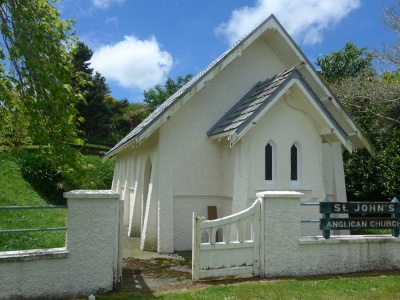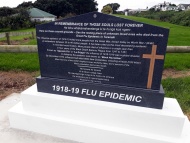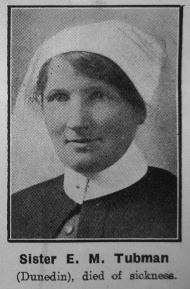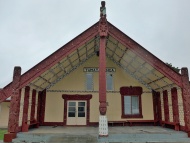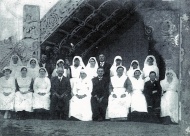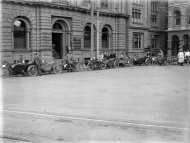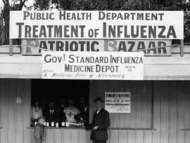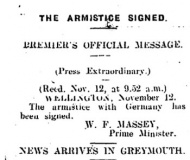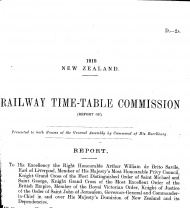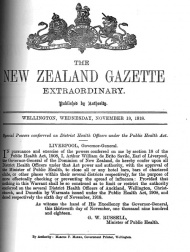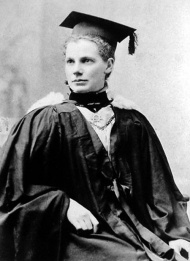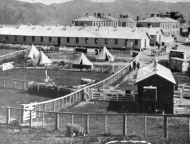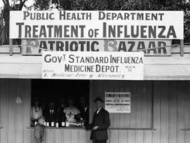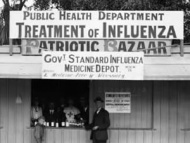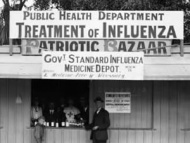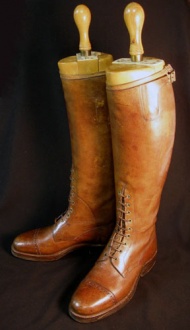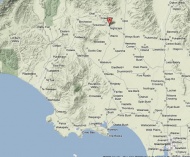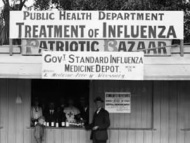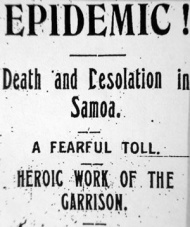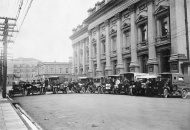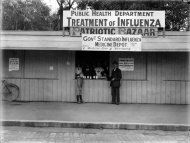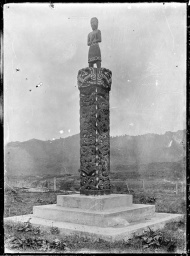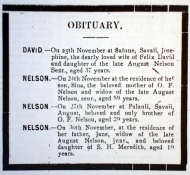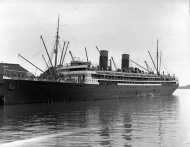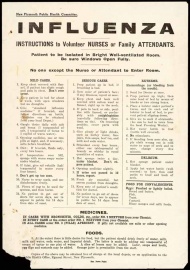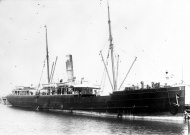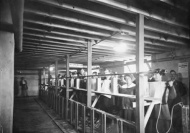Events In History
-
 23 November 1918Influenza pandemic reaches peak mortality
23 November 1918Influenza pandemic reaches peak mortalityNo other event has killed so many New Zealanders in such a short time as the 1918 influenza pandemic. Read more...
-
 12 October 1918Niagara's arrival blamed for flu pandemic
12 October 1918Niagara's arrival blamed for flu pandemicMany people blamed the liner Niagara for bringing a deadly new influenza virus to New Zealand. But six people had died of the flu in Auckland in the three days before it arrived, and the upsurge in cases in the city came two weeks later. Read more...
-
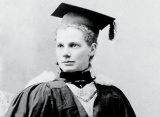 3 May 1897New Zealand's first woman doctor registered
3 May 1897New Zealand's first woman doctor registeredMargaret Cruickshank, the first female doctor registered in New Zealand, practised in Waimate, South Canterbury, until her death from influenza in 1918. Read more...
Articles
The 1918 influenza pandemic

The lethal influenza pandemic that struck New Zealand between October and December 1918 killed about 9000 people in two months. No other event has claimed so many New Zealand lives in such a short time.
-
Page 2 – The pandemic begins abroad
The 1918 influenza pandemic was commonly referred to as ‘the Spanish flu’, but it did not originate in Spain.
-
Page 3 – The pandemic hits New Zealand
Many people believed that the second wave of the 1918 influenza pandemic arrived in New Zealand as ‘a deadly new virus’ on board the RMS Niagara.
-
Page 4 – Uneven rates of death
No other event has killed so many New Zealanders in so short a space of time. While the First World War claimed the lives of more than 18,000 New Zealand soldiers over four
-
Page 5 – Response to the influenza pandemic
There was a degree of consistency in New Zealand's response to the influenza pandemic, thanks to a telegram the Health Minister, George Russell, issued to all borough councils
-
Page 6 – Māori and the flu, 1918–19
Historian Geoffrey Rice suggests that higher death rates among Māori (more than eight times those for Pākehā) may have resulted from lower immunity due to their isolation
-
Page 7 – Aftermath
Robert MakgillFollowing the pandemic, speculation about the Niagara's role in bringing the virus to New Zealand continued.
-
Page 8 – North Island influenza death rates
Death rates from the 1918 influenza pandemic for towns and counties in the North Island
-
Page 9 – South Island influenza death rates
Death rates in South Island towns and counties from the influenza pandemic
-
Page 10 – Influenza in Samoa
The total number of deaths attributable to influenza is estimated as 8500, 22% of the Samoan population
-
Page 11 – Further information
This web feature was written by Imelda Bargas and produced by the NZHistory.net.nz team.
Armistice Day
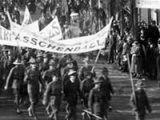
After four terrible years, fighting in the First World War finally ended with the signing of an armistice between Germany and the Allies on 11 November 1918. New Zealanders celebrated enthusiastically, despite having recently celebrated the surrenders of the three other Central Powers and the premature news of an armistice with Germany.
-
Page 2 – Pre-Armistice Day surrenders
From 1 October 1918 New Zealanders progressively celebrated the surrenders of Bulgaria, the Ottoman Empire and Austria-Hungary before the armistice with Germany on 11 November
-
Page 3 – False armistice
On 7 November 1918 the Prime Minister assured the public - following rumours to the contrary - that the government was not holding back news of a German surrender. The next
-
Page 5 – Armistice Day and the flu
The influenza pandemic dampened some armistice celebrations, particularly in Auckland.
-
Page 7 – New Zealand in 1918
Some facts and stats about New Zealand in the year the First World War ended
New Zealand in Samoa
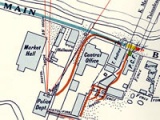
New Zealand was ill-equipped to cope with the Western Samoa mandate it was allocated by the League of Nations in 1920. The Mau movement's passive resistance culminated in the violence of 'Black Saturday', 28 December 1929, which left 11 Samoans and one New Zealand policeman dead.
-
Page 2 – Background
When war broke out in Europe in August 1914, Britain asked New Zealand to seize German Samoa as a 'great and urgent Imperial service'.
Comparing pandemics
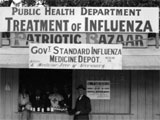
MCH Senior Historian Elizabeth Cox has been pondering the similarities and differences in New Zealand’s response to the 1918 flu pandemic, and the COVID-19 pandemic in 2020. Here are some of her preliminary thoughts.
-
Page 2 – Activities: Comparing pandemics
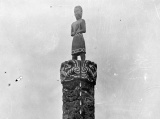
Looking at our experiences of two pandemics a century apart provides an ideal opportunity to explore a number of important historical thinking concepts that those of you
1919 peace celebrations
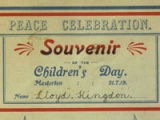
Although the guns fell silent on 11 November 1918, peace wasn't officially proclaimed until 28 June 1919, when the Treaty of Versailles was signed. In July 1919 communities throughout New Zealand and the Empire celebrated peace with elaborate public events over several days.
- Page 2 - Planning gets under wayAlmost immediately after the armistice, communities throughout New Zealand and the Empire began to plan elaborate celebrations that would mark the official end of the war in a
Pacific Islanders in the NZEF
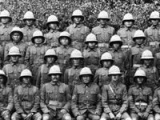
Cook Islanders, Niueans, Fijians and Gilbert Islanders all took their place in the ranks of the New Zealand Expeditionary Force during the First World War. As well as the dangers of war, Pacific soldiers faced language difficulties, an unfamiliar army diet and European diseases.
-
Page 4 – Fijian and Gilbert Island Contingents
Information about men from Fiji and the Gilbert Islands who enlisted for service in the NZEF.
-
Page 5 – Difficulties faced by Pacific Islanders
Information on the difficulties faced by Pacific Islanders when they left their island homes for the first time and entered the army.
Pacific aftermath
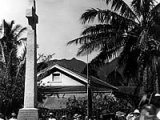
Participation in the First World War changed Pacific Islanders' lives. Returning servicemen had seen the world.
- Page 3 - Troop repatriationWhen the armistice was signed in November 1918, Pacific island troops in New Zealand service were stationed in a number of
Capture of German Samoa

When war broke out in Europe in August 1914, Britain asked New Zealand to seize German Samoa as a ‘great and urgent Imperial service’. Although the tiny German garrison offered no opposition, at the time it was regarded as a potentially risky action.
- Page 4 - Wartime administrationGerman officials were replaced by New Zealand military officers, civilians, or British residents. These often lacked the experience or qualifications to do the
NZ Railways at war
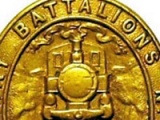
The railway system and its workforce was one of the most valuable assets available to the New Zealand state to support the national effort during the First World War
- Page 5 - Manpower challenges at homeHow did New Zealand Railways (NZR) keep up its massive manpower commitments during the First World War, while still maintaining services to its
Biographies
-
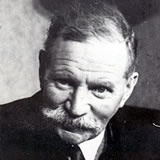 Makgill, Robert Haldane
Makgill, Robert Haldane
Robert Makgill was a key figure in the development of New Zealand's public health system. He was one of the country's first district health officers and played a crucial role during the devastating 1918 influenza pandemic.
Read more... -
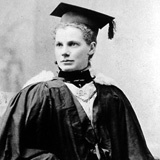 Cruickshank, Margaret Barnet
Cruickshank, Margaret Barnet
Margaret Cruickshank was the first woman to be registered as a doctor in New Zealand. She worked tirelessly during the 1918 influenza pandemic but eventually caught the disease herself and died on 28 November 1918.
Read more... -
 Logan, Robert
Logan, Robert
Robert Logan ran the military administration of German Samoa on behalf of Britain during the First World War.
Read more...
Related keywords
- kaimata
- peace celebrations
- railways
- WW1 home front
- health
- epidemic
- new plymouth
- nurses
- WW1 stories
- last post stories
- te reinga
- māori health
- WW1
- armistice
- doctors
- disease
- training camps
- rarotongan company
- fiji
- gilbert islands
- niue
- shipping
- pacific peoples
- otiria
- germany
- flags
- newspapers
- te kuiti
- motukaraka
- central powers
- holidays
- bulgaria
- ottoman empire
- austro-hungarian empire
- christchurch
- motorcycles
- greymouth
- niagara
- public service
- cook islands
- narrow neck camp
- language
- clothing
- margaret cruickshank
- quarantine
- robert makgill
- samoa
- german samoa occupation
- robert logan
- suffrage 125
- war objects
- richard riddiford
- battle of the somme
- riverton
- death
- nightcaps
- mau movement
- children
- pioneer battalion
- palestine campaign
- sinai campaign
- waimate
- william trethewey
- featherston
- seacliff
- wellington city
- universities
- memorials
- housing
- religion
- population
- alcohol
- six oclock swill
- education
- disasters
- helen clark
-
Main image: St John's Peace Memorial Church
A marble plaque outside St John’s Anglican Church, Kaimata, records its status as a peace memorial

